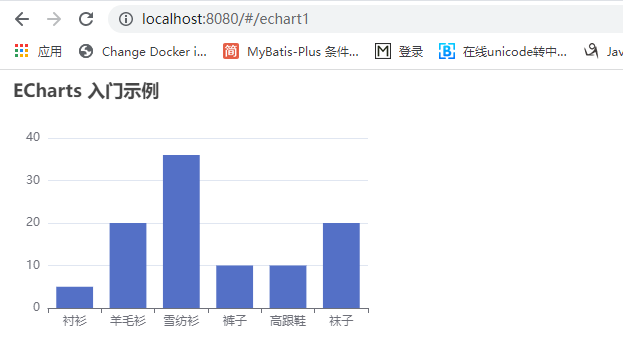博主
258
258
258
258
专辑
- gradle专辑 1
- javaweb专辑 2
- 学习笔记zg4 33
- hutool工具包的使用 13
- Vue3+Element Plus 12
- 跟着禹神学Vue3 1
- 学习笔记zg2(SpringBoot版) 10
- 学习笔记zg2-马 0
- LayUI专辑 14
- 学习笔记zg1 9
第九节 Vue集成echarts
亮子
2022-02-28 08:44:43
17467
0
0
0
1、安装插件
npm install echarts --save
2、创建图表容器
<template>
<div>
<div>
<div id="main1" style="width: 400px;height: 300px;"></div>
</div>
</div>
</template>
3、集成echarts
import * as echarts from 'echarts';
// 基于准备好的dom,初始化echarts实例
let myChart = echarts.init(document.getElementById('main1'));
this.echart1 = myChart
// 准备数据
let option = {
title: {
text: 'ECharts 入门示例'
},
tooltip: {},
xAxis: {
data: ['衬衫', '羊毛衫', '雪纺衫', '裤子', '高跟鞋', '袜子']
},
yAxis: {},
series: [
{
name: '销量',
type: 'bar',
data: [5, 20, 36, 10, 10, 20]
}
]
}
// 绘制图表
myChart.setOption(option);
4、显示效果

5、完整代码
<template>
<div>
<div>
<div id="main1" style="width: 400px;height: 300px;"></div>
</div>
</div>
</template>
<script>
import * as echarts from 'echarts';
export default {
name: 'Echart1',
data() {
return {
echart1: null,
}
},
mounted() {
// 基于准备好的dom,初始化echarts实例
let myChart = echarts.init(document.getElementById('main1'));
this.echart1 = myChart
// 准备数据
let option = {
title: {
text: 'ECharts 入门示例'
},
tooltip: {},
xAxis: {
data: ['衬衫', '羊毛衫', '雪纺衫', '裤子', '高跟鞋', '袜子']
},
yAxis: {},
series: [
{
name: '销量',
type: 'bar',
data: [5, 20, 36, 10, 10, 20]
}
]
}
// 绘制图表
myChart.setOption(option);
},
methods: {
}
}
</script>
<style>
</style>